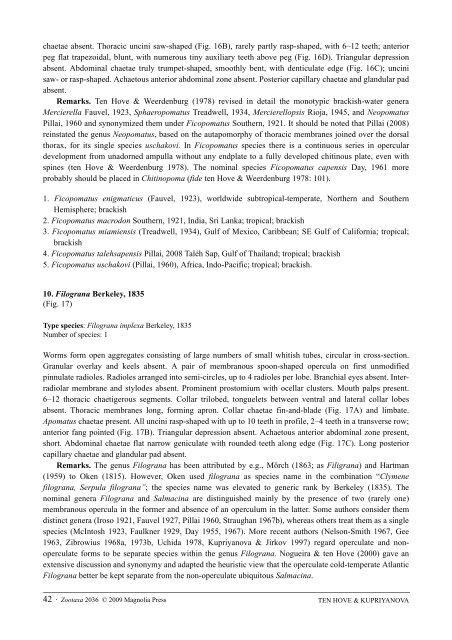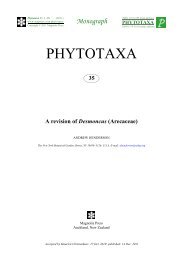Zootaxa, Taxonomy of Serpulidae (Annelida ... - Magnolia Press
Zootaxa, Taxonomy of Serpulidae (Annelida ... - Magnolia Press
Zootaxa, Taxonomy of Serpulidae (Annelida ... - Magnolia Press
Create successful ePaper yourself
Turn your PDF publications into a flip-book with our unique Google optimized e-Paper software.
chaetae absent. Thoracic uncini saw-shaped (Fig. 16B), rarely partly rasp-shaped, with 6–12 teeth; anterior<br />
peg flat trapezoidal, blunt, with numerous tiny auxiliary teeth above peg (Fig. 16D). Triangular depression<br />
absent. Abdominal chaetae truly trumpet-shaped, smoothly bent, with denticulate edge (Fig. 16C); uncini<br />
saw- or rasp-shaped. Achaetous anterior abdominal zone absent. Posterior capillary chaetae and glandular pad<br />
absent.<br />
Remarks. Ten Hove & Weerdenburg (1978) revised in detail the monotypic brackish-water genera<br />
Mercierella Fauvel, 1923, Sphaeropomatus Treadwell, 1934, Mercierellopsis Rioja, 1945, and Neopomatus<br />
Pillai, 1960 and synonymized them under Ficopomatus Southern, 1921. It should be noted that Pillai (2008)<br />
reinstated the genus Neopomatus, based on the autapomorphy <strong>of</strong> thoracic membranes joined over the dorsal<br />
thorax, for its single species uschakovi. In Ficopomatus species there is a continuous series in opercular<br />
development from unadorned ampulla without any endplate to a fully developed chitinous plate, even with<br />
spines (ten Hove & Weerdenburg 1978). The nominal species Ficopomatus capensis Day, 1961 more<br />
probably should be placed in Chitinopoma (fide ten Hove & Weerdenburg 1978: 101).<br />
1. Ficopomatus enigmaticus (Fauvel, 1923), worldwide subtropical-temperate, Northern and Southern<br />
Hemisphere; brackish<br />
2. Ficopomatus macrodon Southern, 1921, India, Sri Lanka; tropical; brackish<br />
3. Ficopomatus miamiensis (Treadwell, 1934), Gulf <strong>of</strong> Mexico, Caribbean; SE Gulf <strong>of</strong> California; tropical;<br />
brackish<br />
4. Ficopomatus talehsapensis Pillai, 2008 Taléh Sap, Gulf <strong>of</strong> Thailand; tropical; brackish<br />
5. Ficopomatus uschakovi (Pillai, 1960), Africa, Indo-Pacific; tropical; brackish.<br />
10. Filograna Berkeley, 1835<br />
(Fig. 17)<br />
Type species: Filograna implexa Berkeley, 1835<br />
Number <strong>of</strong> species: 1<br />
Worms form open aggregates consisting <strong>of</strong> large numbers <strong>of</strong> small whitish tubes, circular in cross-section.<br />
Granular overlay and keels absent. A pair <strong>of</strong> membranous spoon-shaped opercula on first unmodified<br />
pinnulate radioles. Radioles arranged into semi-circles, up to 4 radioles per lobe. Branchial eyes absent. Interradiolar<br />
membrane and stylodes absent. Prominent prostomium with ocellar clusters. Mouth palps present.<br />
6–12 thoracic chaetigerous segments. Collar trilobed, tonguelets between ventral and lateral collar lobes<br />
absent. Thoracic membranes long, forming apron. Collar chaetae fin-and-blade (Fig. 17A) and limbate.<br />
Apomatus chaetae present. All uncini rasp-shaped with up to 10 teeth in pr<strong>of</strong>ile, 2–4 teeth in a transverse row;<br />
anterior fang pointed (Fig. 17B). Triangular depression absent. Achaetous anterior abdominal zone present,<br />
short. Abdominal chaetae flat narrow geniculate with rounded teeth along edge (Fig. 17C). Long posterior<br />
capillary chaetae and glandular pad absent.<br />
Remarks. The genus Filograna has been attributed by e.g., Mörch (1863; as Filigrana) and Hartman<br />
(1959) to Oken (1815). However, Oken used filograna as species name in the combination “Clymene<br />
filograna, Serpula filograna”; the species name was elevated to generic rank by Berkeley (1835). The<br />
nominal genera Filograna and Salmacina are distinguished mainly by the presence <strong>of</strong> two (rarely one)<br />
membranous opercula in the former and absence <strong>of</strong> an operculum in the latter. Some authors consider them<br />
distinct genera (Iroso 1921, Fauvel 1927, Pillai 1960, Straughan 1967b), whereas others treat them as a single<br />
species (McIntosh 1923, Faulkner 1929, Day 1955, 1967). More recent authors (Nelson-Smith 1967, Gee<br />
1963, Zibrowius 1968a, 1973b, Uchida 1978, Kupriyanova & Jirkov 1997) regard operculate and nonoperculate<br />
forms to be separate species within the genus Filograna. Nogueira & ten Hove (2000) gave an<br />
extensive discussion and synonymy and adapted the heuristic view that the operculate cold-temperate Atlantic<br />
Filograna better be kept separate from the non-operculate ubiquitous Salmacina.<br />
42 · <strong>Zootaxa</strong> 2036 © 2009 <strong>Magnolia</strong> <strong>Press</strong><br />
TEN HOVE & KUPRIYANOVA
















